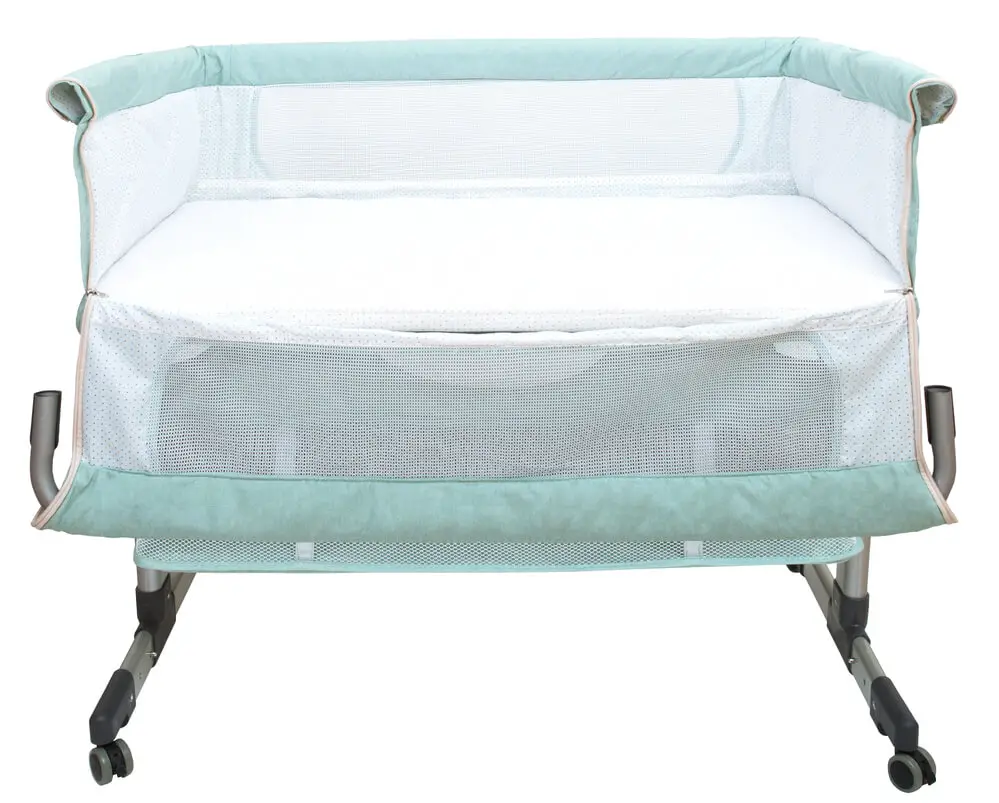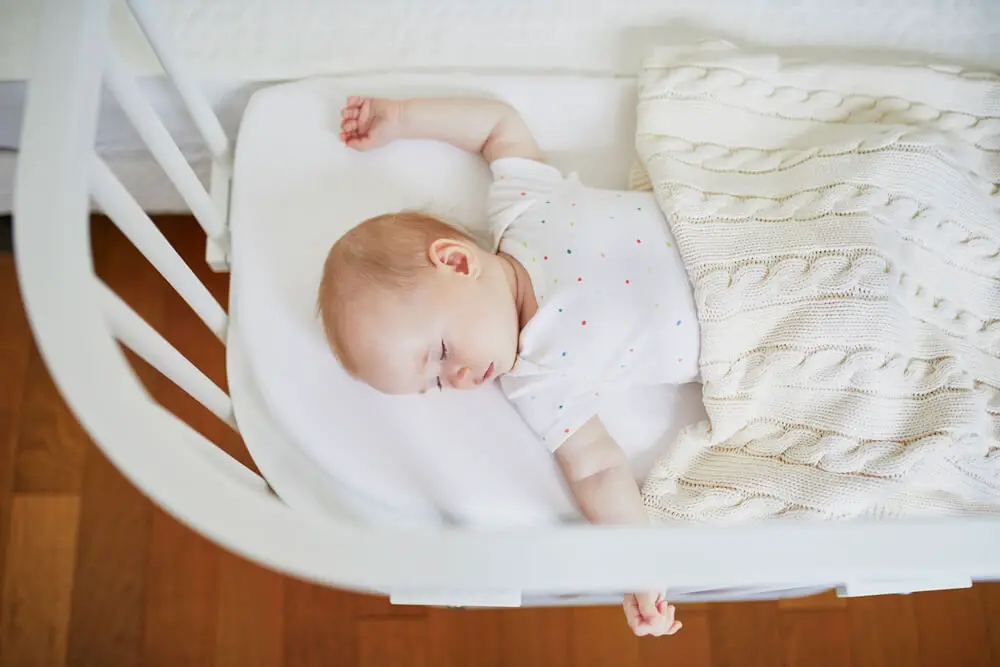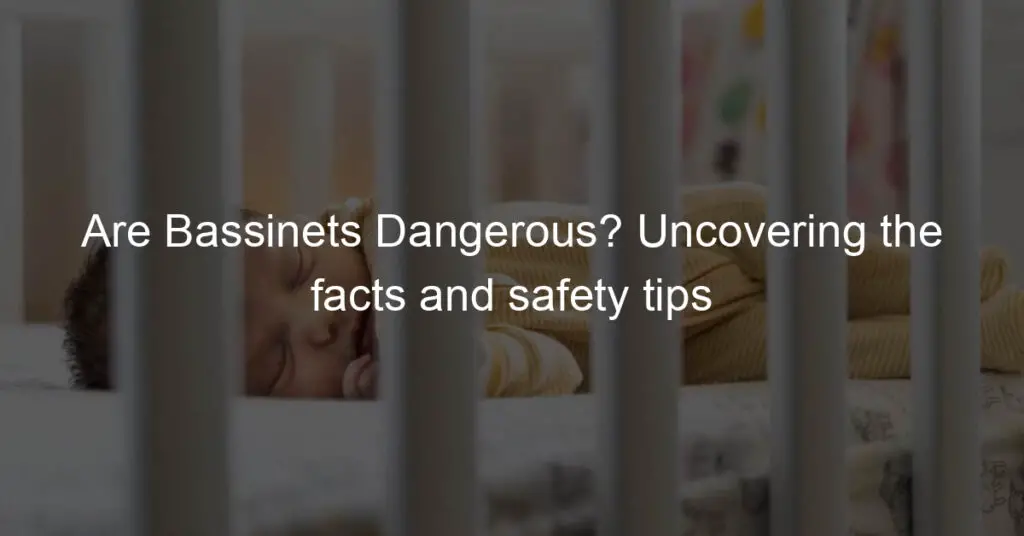Introduction: The Bassinet Safety Debate
When it comes to the safety of our little ones, every parent wants to make the best choices. One such choice is deciding where your baby should sleep. Many parents opt for bassinets, but recently, there has been a growing debate about their safety. This article aims to shed light on this important issue.
Overview of the bassinet safety controversy
The bassinet safety controversy revolves around the potential risks associated with the use of bassinets for infant sleep. Some experts argue that bassinets, due to their design and structure, may pose a risk of suffocation or Sudden Infant Death Syndrome (SIDS). On the other hand, proponents of bassinets argue that they are safe when used correctly and can provide a convenient and comfortable sleeping environment for infants. This debate has left many parents confused and concerned about the best choice for their baby’s sleep.
Importance of infant sleep safety
Ensuring the safety of your baby while they sleep is of utmost importance. According to the American Academy of Pediatrics, approximately 3,500 infants die annually in the United States from sleep-related deaths, including SIDS. Therefore, understanding and implementing safe sleep practices can significantly reduce these risks. Whether you choose a bassinet, crib, or co-sleeping, it is crucial to follow safety guidelines to ensure your baby’s well-being.
In the following sections, we will delve deeper into the history of bassinets, the potential risks they pose, how they compare to cribs, and how to choose a safe bassinet. We will also discuss other aspects of safe baby sleeping beyond the choice of sleeping furniture. Stay tuned to make an informed decision about your baby’s sleep safety.
Understanding Bassinets: A Brief History

When it comes to providing a safe and comfortable sleeping environment for infants, bassinets have been a popular choice for centuries. Let’s take a journey back in time to understand the origins of bassinets and how they have evolved over the years in terms of design and safety features.
- Origins of Bassinets
The term ‘bassinet’ is derived from the French word ‘basin’, which means ‘a little basin’. The earliest bassinets were essentially small baskets or portable beds made of natural materials like wicker or palm. These were designed to provide a cozy, nest-like sleeping space for babies. The concept of a bassinet can be traced back to ancient civilizations. For instance, the story of Moses being placed in a basket and set adrift on the river is one of the earliest references to a bassinet-like structure. Wikipedia provides more information about the historical origins of bassinets.
- Evolution of Bassinet Design and Safety Features
Over the years, the design of bassinets has evolved significantly. In the 19th century, bassinets began to be made from metal and wood, with added features like rockers or wheels for easy movement. In the 20th century, with the advent of plastics, bassinets became lighter and more portable.
As far as safety is concerned, the evolution has been even more dramatic. Early bassinets had no safety standards, but over time, as understanding of infant safety grew, so did the features incorporated into bassinet design. Today’s bassinets come with safety features like breathable mesh sides, firm mattresses, sturdy frames, and adjustable height settings. They also adhere to safety standards set by organizations like the American Academy of Pediatrics and the Consumer Product Safety Commission.
In conclusion, the history of bassinets is a fascinating journey of innovation and a growing understanding of infant safety. As we move forward, it’s exciting to think about how bassinets will continue to evolve to meet the needs of future generations.
Risks of Bassinets: The Hidden Dangers

While bassinets are often seen as a safe and convenient option for newborns, they can also present certain risks. It’s important for parents and caregivers to be aware of these potential hazards to ensure the safety of their little ones. Let’s delve into some of the common dangers associated with bassinets.
- Common Bassinet Hazards
Bassinets, like any other baby product, can pose risks if not used correctly. Here are some of the most common hazards:
- Improper Bedding: Soft bedding can pose a suffocation risk. Always use a firm mattress with a tight-fitting sheet.
- Loose Parts: Loose or broken parts can cause the bassinet to collapse, leading to injury. Regularly check the bassinet for any loose screws or parts.
- Entrapment Hazards: Gaps in the bassinet can trap a baby’s fingers, toes, or limbs. Ensure the bassinet has no spaces wider than 2.3 cm.
- Tip-Over Risks: A bassinet that isn’t stable can tip over easily. Always place the bassinet on a flat, level surface.
- Case Studies of Bassinet-Related Incidents
Real-life incidents can help us understand the potential dangers of bassinets. Let’s look at some case studies:
In 2008, the Consumer Product Safety Commission reported a case where a 4-month-old girl from Missouri suffocated when she rolled onto the side of her bassinet. The bassinet had a design flaw that allowed the fabric to loosen, creating a gap where the baby could roll into and suffocate.
Another case in 2010 involved a 3-month-old boy from Georgia who suffocated in a bassinet with a drop-side rail. The side rail had detached, creating a gap where the baby’s head became entrapped.
These cases underscore the importance of choosing a safe bassinet and using it correctly. Always check for product recalls and follow the manufacturer’s instructions for assembly and use.
Bassinets vs Cribs: A Comparative Analysis
When it comes to choosing a sleeping option for your newborn, the decision can be challenging. The two most common choices are bassinets and cribs. Both have their advantages and disadvantages. Let’s explore them in detail.
Newborn Sleeping Options: Pros and Cons
Advantages of Bassinets
Bassinets are smaller and more portable than cribs. This makes them ideal for parents who want to keep their newborn close during the night. They are also lower to the ground, making it easier for parents to reach in and soothe their baby. Furthermore, bassinets are typically less expensive than cribs.
Disadvantages of Bassinets
One of the main disadvantages of bassinets is that they have a shorter lifespan. Babies outgrow them within a few months. Moreover, they don’t offer as much space for the baby to move around. Some bassinets also lack the sturdy construction of a crib, which could pose safety risks.
Advantages of Cribs
Cribs are larger and offer more space for your baby to grow. They are built to last and can be used for several years, making them a cost-effective solution in the long run. Cribs also come with adjustable mattress heights, which can be lowered as your baby grows and becomes more mobile.
Disadvantages of Cribs
The size of cribs can be a disadvantage for parents with limited space. They are also more expensive upfront and less portable than bassinets. Additionally, the height of cribs can make it more difficult for parents to reach in and pick up their baby, especially in the middle of the night.
In conclusion, the choice between a bassinet and a crib depends on your specific needs and circumstances. Consider factors such as space, budget, and convenience before making a decision.
Safe Baby Sleeping: Beyond Bassinets and Cribs

While bassinets and cribs are the most common sleeping options for infants, there are other alternatives that can also ensure your baby’s safety and comfort. Let’s explore these options and understand the importance of a safe sleep environment and routine for your little one.
- Alternative Safe Sleeping Options for Infants
When it comes to your baby’s sleep, safety should be your top priority. Here are some alternatives to bassinets and cribs that are considered safe for infants:
- Portable Play Yards: These are lightweight, easy to assemble, and can be moved around the house. They come with a firm mattress and a fitted sheet, providing a safe sleep environment for your baby. Wikipedia provides more information about portable play yards.
- Bedside Sleepers: These are designed to attach to your bed, allowing your baby to sleep close to you while having their own safe space. They are a great option for parents who want to keep their baby nearby for feeding and comforting during the night.
- Travel Cribs: These are similar to portable play yards but are more compact and lightweight, making them ideal for travel. They also come with a firm mattress and a fitted sheet.
- Importance of Sleep Environment and Routine
Creating a safe sleep environment and establishing a consistent sleep routine are crucial for your baby’s health and development. Here’s why:
- Reduced Risk of SIDS: A safe sleep environment can significantly reduce the risk of Sudden Infant Death Syndrome (SIDS). This includes using a firm sleep surface, keeping the sleep area free of loose bedding and toys, and placing your baby on their back to sleep.
- Better Sleep Quality: A consistent sleep routine can improve your baby’s sleep quality. This includes setting regular nap times and bedtime, creating a soothing pre-sleep routine, and ensuring the sleep environment is quiet and dark.
- Healthy Development: Good sleep is essential for your baby’s physical growth, brain development, and emotional well-being. A safe sleep environment and routine can help ensure your baby gets the rest they need.
In conclusion, while bassinets and cribs are common choices, there are other safe sleeping options for infants. Regardless of the option you choose, remember the importance of a safe sleep environment and a consistent sleep routine for your baby’s health and development.
Choosing Safe Bassinets: What to Look For
When it comes to the safety of your precious little one, choosing the right bassinet is crucial. A bassinet is more than just a cozy sleeping spot for your baby, it’s a place where your baby will spend a significant amount of their time during the first few months. Therefore, it’s important to ensure that the bassinet you choose is not only comfortable but also safe. Here are some key features to look for when shopping for a bassinet.
Bassinet Safety Features: A Checklist
Here is a checklist of safety features that you should consider when choosing a bassinet:
- Stable base and sturdy construction: A good bassinet should have a stable base and sturdy construction to prevent it from tipping over. It should be able to withstand your baby’s movements without wobbling or shaking.
- Firm, tight-fitting mattress: The mattress in the bassinet should be firm and fit snugly within the frame. A soft or loose mattress can create a suffocation hazard for your baby.
- No protruding hardware or small parts: Ensure that the bassinet does not have any protruding hardware or small parts that could pose a choking hazard. All screws, bolts, and other hardware should be securely fastened and not accessible to the baby.
- Good ventilation: The bassinet should have good ventilation. Mesh sides are a good feature to look for as they allow air to circulate freely, preventing your baby from overheating.
- Compliance with safety standards: The bassinet should comply with all relevant safety standards. In the United States, for example, bassinets should meet the safety standards set by the Consumer Product Safety Commission (CPSC). You can check the label or product description to ensure compliance.
Remember, the safety of your baby is paramount. Don’t compromise on these safety features when choosing a bassinet. It’s always better to be safe than sorry.
Conclusion: Ensuring Infant Sleep Safety
As we wrap up our discussion on bassinet safety, it’s essential to revisit the importance of safe sleeping for infants. The safety of your little one is paramount, and understanding the best practices for infant sleep safety can make all the difference.
Reiteration of the importance of safe sleeping:
Safe sleeping is not just about comfort, it’s about protecting your baby from risks like Sudden Infant Death Syndrome (SIDS). According to the American Academy of Pediatrics, placing your baby to sleep on their back, in a crib or bassinet free from loose bedding, toys, and soft objects, can significantly reduce the risk of SIDS. This highlights the importance of safe sleeping practices.
Final thoughts on bassinet safety:
Bassinets can offer convenience and comfort for new parents and their babies. However, it’s crucial to ensure that the bassinet you choose meets safety standards. Look for a sturdy, stable bassinet with a firm, tight-fitting mattress. Avoid bassinets with soft bedding, pillows, or plush toys that could pose a suffocation risk. Remember, safety should always be your top priority when it comes to your little one’s sleep environment.
In conclusion, ensuring infant sleep safety is a responsibility that all parents and caregivers must take seriously. By understanding the risks and taking the necessary precautions, we can create a safe and comfortable sleep environment for our little ones.














